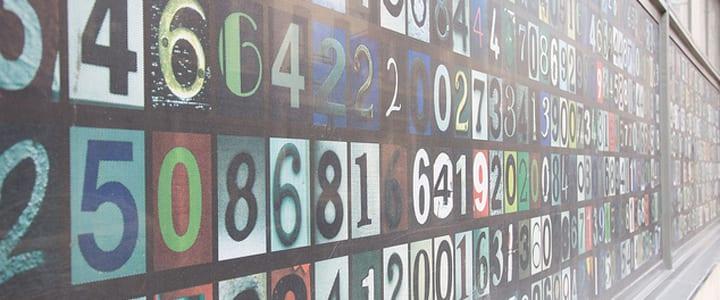 Are your French vocabulary lessons not adding up? Perhaps this lesson in numbers, counting, and math from French tutor Carol Beth L. will multiply your comprehension…
Are your French vocabulary lessons not adding up? Perhaps this lesson in numbers, counting, and math from French tutor Carol Beth L. will multiply your comprehension…
Numbers come up everywhere – and they are so numerous that it sometimes takes time to assimilate them automatically into everyday speech when you are learning another language. In her biography, Marie Curie’s daughter stated that her mother, who was born Polish but lived most of her life in France, would count to herself in Polish – not French – even into her old age. Oddly enough, in this way, numbers can tell others about your connection with your new language.
The numbers from 1 to 20 in French are best to memorize. With some pronunciation notes in parenthesis, They are:
1 un (with a nasal “n”)
2 deux (silent “x”)
3 trois (silent “s”)
4 quatre (“katre” or, when you’re speaking quickly, “kat”)
5 cinq (“seink”)
6 six (“sees,” but pronounce both the first and last syllable like an “s,” not a “z”)
7 sept (“set”)
8 huit (like the English word “wheat”)
9 neuf
10 dix (pronounce the “x” like an “s”)
11 onze (silent “e”)
12 douze (again, silent “e”)
13 treize (again, silent “e”)
14 quatorze (“katorz”)
15 quinze (“kanz”)
16 seize (as in “he says, she says”)
17 dix-sept (like 10 & 7, and the two s-sounds run together into an extra long one)
18 dix-huit (like 10 & 8, but the “x” sounds a little more like a “z”)
19 dix-neuf (with another z-like “x”)
20 vingt (like “van,” but the the “n” is nasal)
Here is a quick video on numbers 1-60 if you need some extra help learning to pronounce them:
From twenty to one hundred, patterns for numbers become more regular. Simply put the appropriate numbers together. Here are 21 – 29:
21 vingt-et-en
22 vingt-deux
23 vingt-trois
24 vingt-quatre
25 vingt-cinq
26 vingt-six
27 vingt-sept
28 vingt-huit
29 vingt-neuf
Note the “et” between 20 and 1 in 21. This is one of the language’s beloved exceptions coming back to haunt French learners – though it helps that it is a regular enough exception. It occurs again in several more numbers ending in 1: 31, 41, 51, and 61.
Once you’ve got this, all you need to count to 100 are the remaining 10’s:
30 trente
40 quarante
50 cinquante
60 soixante
70 soixante-dix (or “septante” in Belgium)
80 quatre-vingt (or “octante” in Belgium)
100 cent
Et voilà! Now you can count to one hundred in French.
But what if you want to do math in French as well? For simple functions, it isn’t too difficult. A few vocabulary words to help you out are:
égaler to equal
égale equals (3rd person singular)
diviser to divide
divisé par divided by
plus (say “u” like “oo”) plus
moins minus or negative
fois times
faire to make
font make (3rd person plural)
Here are some examples to put it all together. When more than one version is presented, the first one is more formal than the second one.
2 + 2 = 4
Deux plus deux égale quatre. (Two plus two equals four.)
Deux et deux font quatre. (Two and two make four.)
9 – 3 = 6
Neuf moins trois égale six. (Nine minus three equals six.)
Neuf moins trois fait six. (Nine minus three make six.)
8 x 8 = 64
Huit fois huit égale soixante-quatre. (Eight times eight equals sixty-four.)
Huit fois huit fait soixante-quatre. (Eight times eight makes sixty-four.)
20 / 5 = 4
Vingt divisé par cinq égale quatre. (Twenty divided by five equals four.)
Try figuring out a few on your own:
3 x 4 = 12
90 / 10 = 9
16 + 22 = 38
24 – 13 = 11
42 / 2 = 21
26 – 11 = 15
33 + 31 = 64
19 x 2 = 38
How well do you think you did? Hopefully, you did all right. Keep practicing, and try to apply it to your everyday life. Count, add, subtract, divide, and multiply the miles you drive, the steps you walk, the glasses of water you drink, the food you share with you family, the money you pay for your next purchase, and anything else that will allow to review. Soon enough, you’ll be a natural!
For more help learning French vocabulary, sign up for lessons with a private French tutor. Tutors are available to teach you in-person or online via Skype. Find your French tutor today!

Carol Beth L. teaches French lessons in San Francisco, CA. She has her Masters in French language education from the Sorbonne University in Paris and has been teaching since 2009. Learn more about Carol Beth here!
Photo by morebyless
Suzy S.

